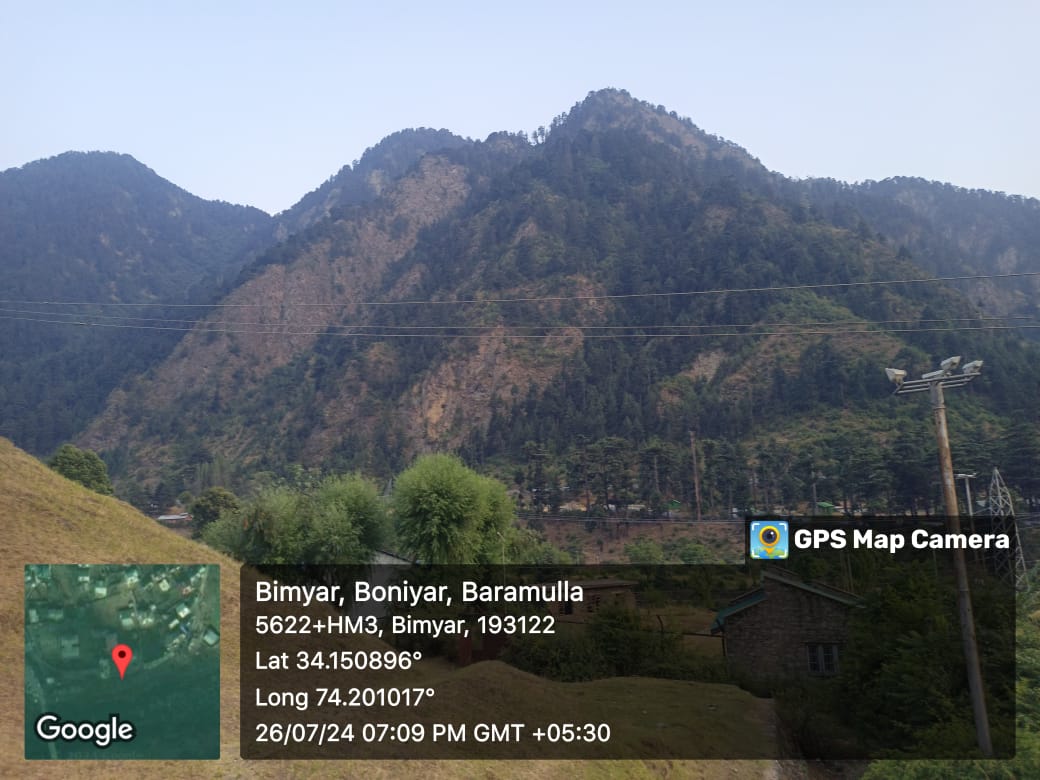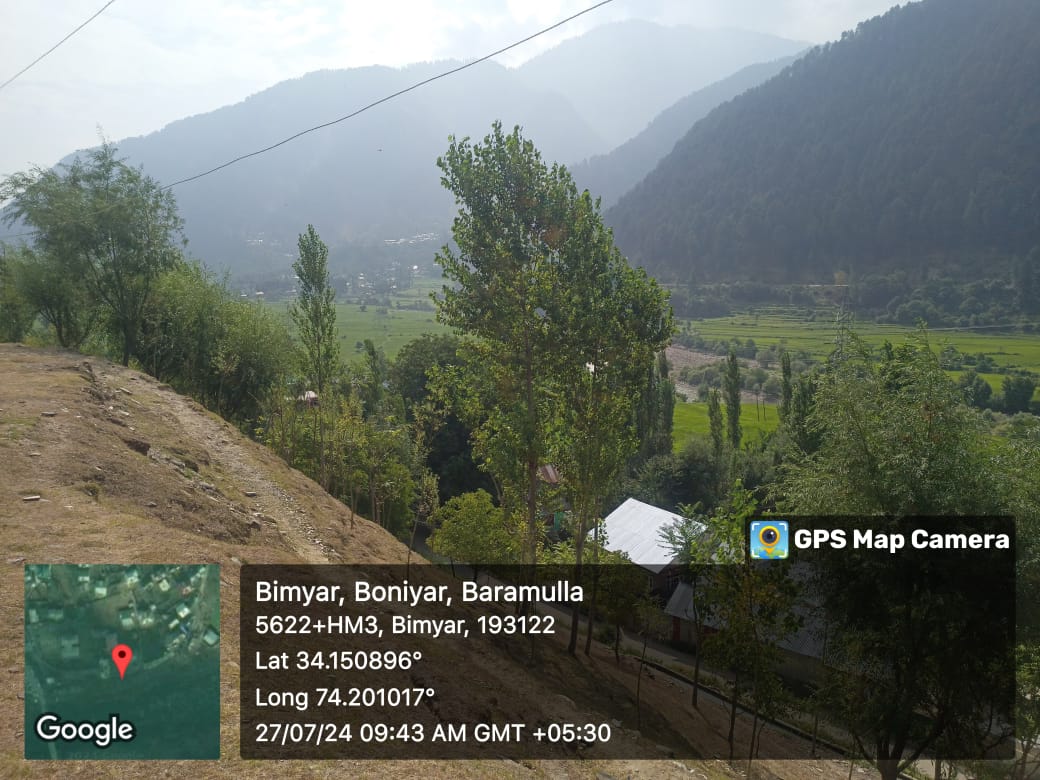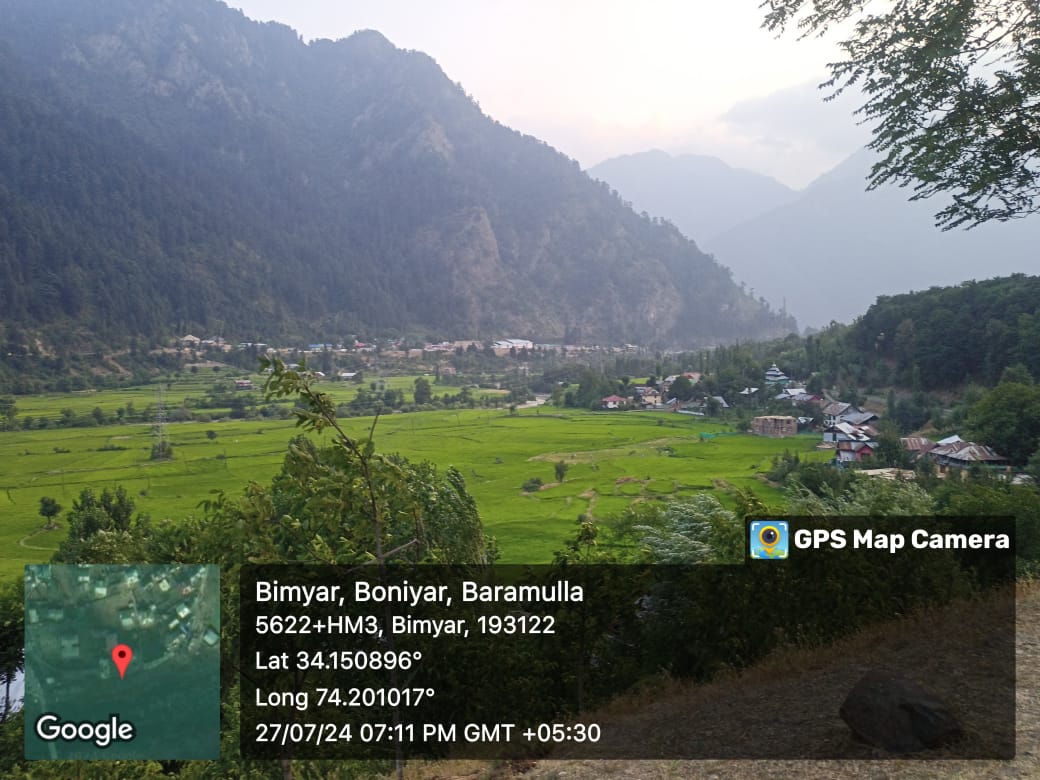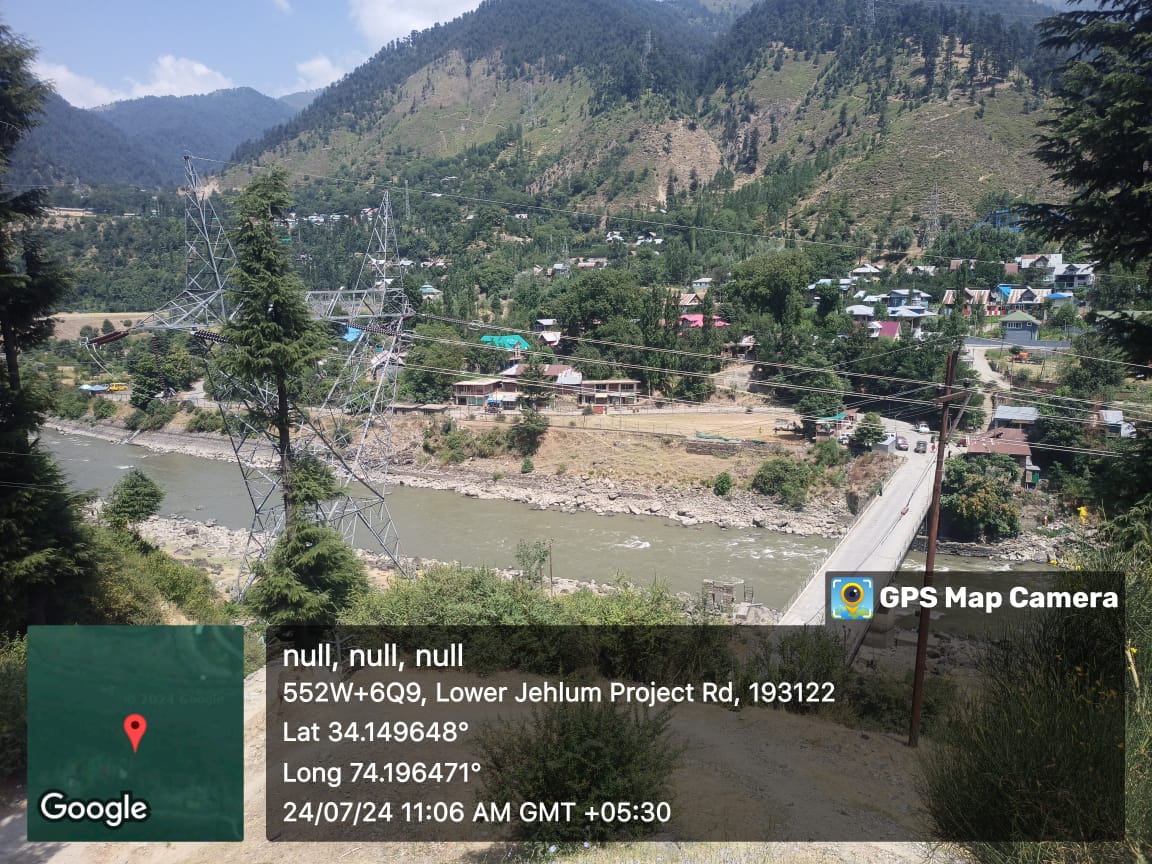Description
INTRODUCTION
Bimyar is a village located in the Boniyar Tehsil of Baramulla district in Jammu & Kashmir, India. It is situated about 5 km from the sub-district headquarters in Boniyar and 20 km from the district headquarters in Baramulla. Bimyar is known for its scenic beauty and adds proximity to the town of Uri, which is about 30 km away.
A blend of rustic beauty and cultural legacy can be seen in Bimyar's scenery, which is filled with traditional Kashmiri homes and agricultural fields. The majority of the locals work as farmers, growing crops including apples, rice, and maize. In addition to being abundant in natural resources, the region provides a tranquil heaven for people looking to get away from the hustle and bustle of the city.
POPULATION AND URBANIZATION
Population overview
The village has a population of approximately 2784 people.
Males : 1490
Females : 1294
Children (0-6 years) : 679
Sex ratio : 868 females per 1000 males
Literacy Rate :
The literacy rate in Bimyar is about 62.14% .
Male literacy : 75.36%
Female literacy : 47.55%
URBANIZATION AND DEVELOPMENT
Infrastructure: The village has basic infrastructure including roads, schools, and healthcare facilities.
Educational Institutions: There are primary and secondary schools providing education to the children of the village.
Healthcare: Basic healthcare facilities are available, with access to larger hospitals in nearby towns.
Development Projects:
Ongoing efforts to improve infrastructure and living conditions, including road improvements and better access to utilities.
Bimyar is a village located in the Baramulla district of Jammu and Kashmir, India. The cultural heritage of Bimyar, like many villages in the Kashmir Valley, is deeply rooted in the region's rich historical, religious, and social traditions.
Language and Literature:
The primary languages spoken in Bimyar is Kashmiri and pahari, a language with a rich literary tradition. Kashmiri poetry, folklore, and traditional songs are an integral part of the village's cultural expression.
Religion and Spirituality:
Religion : The majority of the population in Bimyar practices Islam, which greatly influences the cultural and spiritual life of the village. Sufi traditions, including the veneration of saints and visits to shrines (Ziarats), are common. Also a very few no of people practice hindusim.
Festivals : Religious festivals like Eid-ul-Fitr, Eid-ul-Adha, and Urs (commemorations of Sufi saints) are celebrated with communal prayers, feasts, and cultural performances.
Arts and Crafts :
Handicrafts :Like many areas in Kashmir, Bimyar has a tradition of producing handicrafts, including carpetsThese crafts are not only a source of income but also a means of preserving cultural identity.
Cuisine:
Kashmiri Cuisine : The village's culinary traditions are an essential part of its cultural heritage. Dishes like Rogan Josh, Yakhni, and Dum Aloo, along with the famous Kahwa (a traditional green tea), are staple foods that reflect the rich gastronomic history of the region.
Wazwan : A multi-course meal, Wazwan is a significant cultural practice in Bimyar, especially during weddings and festivals. It is considered an art form and is a point of pride for the villagers.
Music and Dance:
Traditional Music: The music of Bimyar, characterized by the use of traditional instruments like the Rabab, Santoor, and Surnai, plays a vital role in cultural ceremonies and festivities.
The Lower Jhelum Hydroelectric Project (LJHP) :
The Lower Jhelum Hydroelectric Project (LJHP) is a hydroelectric power facility located in Bimyar village, Baramulla district, Jammu and Kashmir. Built on the Jhelum River, LJHP is one of the primary sources of electricity generation in the region. The project harnesses the river’s flow to generate power, contributing to the energy needs of Jammu and Kashmir. It plays a crucial role in both local infrastructure and regional development, supplying electricity to nearby areas and supporting local economic activities. The facility is also important for local employment and providing jobs to the residents.
BEST TIME TO VISIT:
The best time to visit Bimyar is during the summer season. This season offer pleasant weather, making it ideal for exploring the village and its surroundings.
Bimyar, a quaint village in the Baramulla district of Jammu and Kashmir, offers visitors a blend of natural beauty and cultural richness. While it is not a mainstream tourist destination, its serene environment and unique charm attract those seeking tranquility and an authentic rural experience.
Local Natural Landscapes:
Bimyar is surrounded by the mesmerizing beauty of the Himalayan foothills. The village provides scenic views of lush green valleys, dense forests, and meandering streams. Nature enthusiasts can enjoy peaceful walks and explore the unspoiled beauty of the area.
RESERVIOR : The reservoir area is not only significant for its utility but also draws attention for its natural beauty, making it a peaceful spot for visitors exploring Baramulla. It is part of the region's picturesque landscapes that contribute to the charm of Kashmir Valley.
Jhelum River: The Jhelum River flows nearby, adding to the village's charm.
Visitors can relax by the riverside, enjoy the soothing sound of flowing water, and even engage in fishing or photography.
Proximity to Uri: Being close to the town of Uri, visitors can explore nearby attractions such as the Uri Hydroelectric Project or sites that hold historical and cultural significance.
Cultural Experience: Though not a specific tourist site, the village offers a chance to experience traditional Kashmiri lifestyle, cuisine, and hospitality. Tourists can interact with the locals to learn about their customs and heritage.
Bimyar's peaceful ambiance makes it an ideal spot for off-the-beaten-path travelers who want to immerse themselves in the natural and cultural beauty of rural Kashmir.
SEASONS:
Spring (March to May): Fields bloom with flowers, fruit trees blossom, and the weather is mild and pleasant.
Summer (June to August): Lush greenery thrives, days are warm with cool evenings, and it's the peak farming season.
Autumn (September to November): Golden foliage blankets the village, weather is crisp, and locals harvest apples and walnuts.
Winter (December to February): Snow covers the landscape, temperatures drop, and life slows with a focus on indoor activities.
ROAD CONNECTIVITY:
Local Roads: Bimyar is well-connected by local roads, making it accessible from nearby villages and towns.
State Highways: The village is connected to state highways, facilitating travel to larger towns and cities in the region.
PUBLIC TRANSPORT
Buses: Regular bus services operate from Kotli Shah Daula to nearby towns and cities, providing a reliable mode of transportation for residents and visitors.
Sumos: Sumo's are available for travel to nearby areas.
Educational Infrastructure :
Government Schools:
• Primary and middle schools provide basic education.
• Limited resources and infrastructure pose challenges.
Private Schools:
A few private institutions offer better facilities and quality education compared to government schools.
Secondary Education:
Students often travel to nearby areas for high school education due to limited local options.
Higher Education:
No colleges in the village; students go to Baramulla or other towns for higher studies.
Challenges:
Poor infrastructure, lack of internet access, and transportation issues affect education.
Government Efforts:
Initiatives like free uniforms, scholarships, and mid-day meals to improve attendance.
ECONOMY:
The economy of Bimyar, like many rural areas in the region, is primarily agrarian. The villagers depend largely on agriculture, with the cultivation of crops such as rice, maize, and vegetables forming the backbone of their livelihoods. The fertile land and the presence of water sources from nearby streams and rivers contribute to successful crop production.
In addition to farming, animal husbandry plays a significant role in the local economy, with many households raising cattle, sheep, and poultry for milk, meat, and wool. This provides both sustenance and additional income for the families.
Seasonal employment and government schemes also support the local economy. In recent years, there has been a growing awareness of the need for alternative livelihoods, such as handicrafts, although such ventures are still limited compared to traditional agricultural practices.
While the region has potential for growth, challenges such as infrastructural limitations, occasional disruptions due to political instability, and a reliance on agricultural income make the village's economy vulnerable to external factors.
CHALLENGES :
The people of Bimyar, face a number of challenges that impact their daily lives and economic well-being. Some of the key challenges include:
Geographical Isolation and Poor Infrastructure :
Bimyar is a rural village with limited access to modern infrastructure. The village faces difficulties in connectivity, including poor roads and limited public transportation. This isolation makes it harder for villagers to access markets, educational institutions, healthcare facilities, and government services.
Lack of proper electricity supply in some areas and limited access to the internet further hampers development and communication.
Agricultural Dependency and Vulnerability :
The economy of Bimyar is heavily reliant on agriculture, particularly rice, maize, and vegetables. This makes the community vulnerable to factors like unpredictable weather patterns, droughts, and floods. The region’s agricultural productivity is also threatened by poor irrigation facilities, outdated farming techniques, and lack of access to modern agricultural tools.
The dependence on a single sector for livelihood also limits diversification of income sources, leaving the population at risk if agricultural yields are low.
Limited Access to Education and Employment Opportunities :
While there are schools in the area, educational facilities may not always meet modern standards. This results in lower literacy rates and fewer opportunities for young people to pursue higher education or vocational training.
The lack of skill-based education programs or industries in the region also means that there are fewer job opportunities outside of traditional farming and animal husbandry, leading to high rates of unemployment or underemployment.
Political Instability and Security Concerns :
The ongoing political instability in Jammu and Kashmir, stemming from conflict and security issues, has a direct impact on the socio-economic conditions of rural villages like Bimyar. Periodic curfews, strikes, and military presence can disrupt normal life, limit access to resources, and cause economic stagnation.
Tourism, which could provide an additional source of income, is often affected by security concerns, limiting potential economic growth in the region.
Healthcare Access and Public Health Challenges :
While there may be local healthcare facilities, they are often under-equipped and understaffed, leading to insufficient healthcare services. The nearest well-equipped hospitals may be far away, making access to medical care difficult, especially in emergencies.
The region also faces health challenges like poor sanitation, limited access to clean drinking water, and inadequate public health awareness.
Environmental Issues and Natural Disasters :
Being situated in a mountainous and flood-prone area, Bimyar faces environmental challenges such as flooding, landslides, and soil erosion. These natural disasters can damage crops, homes, and infrastructure, leading to economic losses and displacement.
The region’s dependence on agriculture makes it especially vulnerable to changes in the climate, such as erratic rainfall or temperature fluctuations.
Lack of Market Access and Agricultural Support :
Farmers in Bimyar face challenges in accessing larger markets to sell their produce, which often results in poor pricing and limited income. Additionally, there is limited access to government schemes that could help improve farming techniques, provide subsidies, or offer financial support.
The lack of agro-processing industries in the region further limits value addition to locally grown crops, keeping the income from agriculture low.
Youth Migration :
Due to limited opportunities for education and employment within the village, many young people migrate to urban centers or outside the region in search of better prospects. This leads to a loss of skilled and educated youth, which further stunts local development and leaves behind an aging population.
Overall, while the people of Bimyar are resilient and maintain a strong sense of community, these challenges make it difficult for the village to achieve long-term sustainable development. Addressing issues such as infrastructure, education, healthcare, and economic diversification would be crucial for improving the lives of the people in Bimyar.
Photos
Videos
Location Map
Contact Information
| Phone Number |
8825061145 |
| Website | https://jkpanchayat.jk.gov.in/directorypanch.php?panchayat=Bimyar-A |
Reviews (1)






































The mountains and the beauty of the village